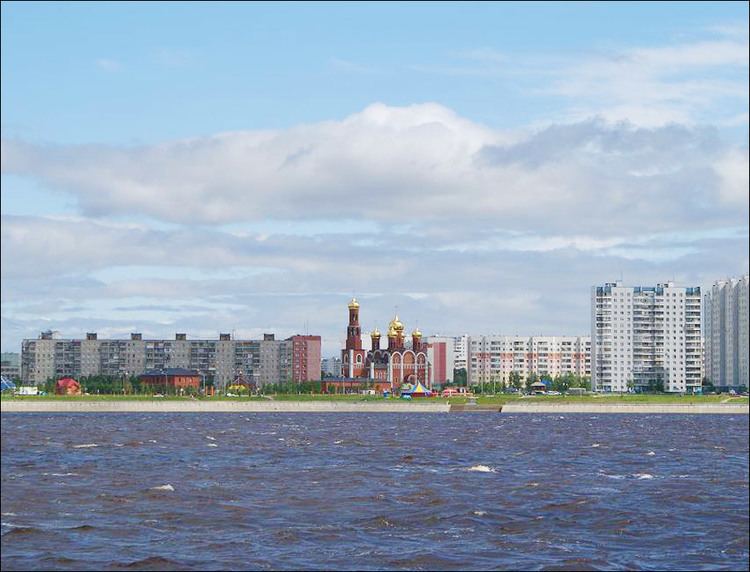Founded 1909 | Population 251,694 (2010) Mayor Boris Khokhryakov | |
 | ||
Map of Nizhnevartovsk
Nizhnevartovsk (Russian: Нижневартовск; [nʲɪʐnʲɪˈvartəfsk]) is a city in Russia, Khanty-Mansia, that serves as administrative center of Nizhnevartovsk district. It is located 30 km away from the Tomsk Oblast border along the right bank of the Ob River beside Samotlor oil field.
Contents
- Map of Nizhnevartovsk
- 4 neos nizhnevartovsk 2013 timelapse
- City of nizhnevartovsk russia church area
- History
- Location
- Climate
- Economy
- Government
- In popular culture
- References

Since the 1960s – an age of active exploration of West Siberia's oil fields – the small settlement began to grow rapidly, and nowadays it has become a modern and comfortable city.
Population: 251,694 (2010 Census); 239,044 (2002 Census); 241,457 (1989 Census).
4 neos nizhnevartovsk 2013 timelapse
City of nizhnevartovsk russia church area
History
It was founded in 1909; its development into a large city was boosted in the 1960s by the discovery of the Samotlor Oil Field, the largest in the country. Town status was granted to it on March 9, 1972.
Location
Nizhnevartovsk is situated in the Sredneobskaya Lowland of West Siberian Plain, in the middle course of the Ob River on its northern bank. Geographical coordinates are 60°57′00″N 76°36′00″E.
Climate
Under the Köppen climate classification, using the 0 °C (32 °F) isotherm, Nizhnevartovsk features a boreal climate (Dfcb).
Winters are cold and humid, and prevailing wind patterns that blow from the South. The daily mean temperature in January, the city's coldest month, is −25.8 °C (−14.4 °F). Summers are typically warm and humid, but short, with a daily mean temperature of 18.2 °C (64.8 °F) in July. Transitional seasons are short.
The city receives 400–620 millimetres (15.7–24.4 in) of precipitation annually, mostly spread throughout the summer months. Average winter snowfall is 70–80 centimetres (27.6–31.5 in); this varies considerably from year to year.
Economy
Nizhnevartovsk is the center of the West Siberian oil-producing region and one of the wealthiest cities in the country.
Government
Within the framework of administrative divisions, Nizhnevartovsk serves as the administrative center of Nizhnevartovsky District, even though it is not a part of it. As an administrative division, it is incorporated separately as the city of okrug significance of Nizhnevartovsk—an administrative unit with the status equal to that of the districts. As a municipal division, the city of okrug significance of Nizhnevartovsk is incorporated as Nizhnevartovsk Urban Okrug.
In popular culture
The cify of Nizhnevartovsk features prominently in the opening of Tom Clancy's novel Red Storm Rising, a novel which details a hypothetical war between NATO and the Warsaw Pact. In the novel, Nizhnevartovsk is depicted as a significant center for petroleum in the Soviet Union, serving as a well and a refinery. Ultimately, Ibrahim Tolkhaze, an Azerbaijani engineer at the refinery whose grandfather was involved with anti-Soviet Azerbaijani nationalists, becomes dislillusioned with Marxism-Leninism due to their atheistic rejection of Islam. As a result, he is driven to form a conspiracy with his allies in the MVD and lead a terrorist attack on the compound. The men sabotage the compound, killing themselves with an explosion. The ensuing fire engulfs the facility, causing a serious setback for the underperforming Soviet petroleum industry. As a result, a major economic crisis occurs due to a looming energy crisis from oil shortages. The Politburo decides that it will be unable to purchase grain from the West without oil revenue, and decides to pursue an invasion of the Persian Gulf to capture its oil fields. In order to prevent American intervention, the Soviets attempt to break up NATO by invading and occupying Western Europe. This fails to have the desired effect of deterring the United States, instead causing World War III.
